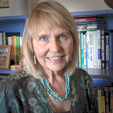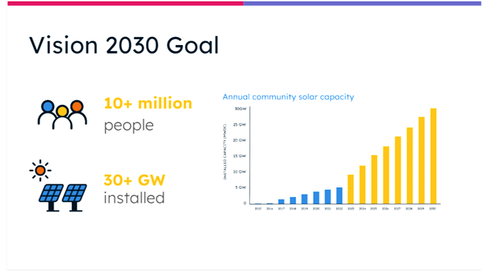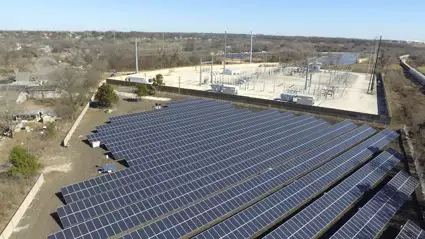
By Jill Cliburn
At the Solar Value Project, we believe 2023 marks a shift in our industry and our work. Many utilities, including electric co-ops and public power, are embracing renewables, and some are accepting the challenges of advancing community solar, DERs and local grid orchestration. Utility relationships with wholesale suppliers and markets are still in flux, as are their relationships with business partners that are big and getting bigger. Yet the communities that these utilities serve are clear in their focus on local benefits. As the clean energy transition takes off, we see tension between the drive for speed and scale on the one hand and for local decision-making, resilience, and social equity on the other. There is a role and a reason for local utilities to join in the work of striking this delicate balance.
I came to this conclusion while attending the recent National Community Solar Summit, co-sponsored by the Coalition for Community Solar Access (CCSA), as well as SEIA and SEPA. The event was co-located with a second summit, organized by the U.S. DOE-sponsored National Community Solar Partnership (NCSP). These tandem summits could easily have drawn stark contrasts between opposing visions—and each summit did hold a distinct perspective. But the meetings unfolded more as a game of Red Rover, where each side (one more motivated by business and one more motivated by social change) invited the other to “come over” and create a difficult, but necessary coalition.
What makes coalition-building necessary? By definition, community solar should bring community benefits, but speed and scale can be commanding forces. According to the National Renewable Energy Lab (NREL), more than 5.7 GW of community solar was installed nationwide by mid-year 2022. Twenty-two states, plus Washington, D.C., have sanctioned community solar policies and programs. Unique community solar programs, characterized as voluntary, also exist in 20 states. Community solar is likely to double over the next five years, but the DOE and community solar proponents would like to see the capacity in this sector soar even higher, to 30 GW or more by 2030.
The technical innovations and growth strategies emerging are impressive. Yet some summit participants have argued that fast growth and competition among community solar businesses could undermine local economic benefits, resilience, and social equity. Some panelists derided trends toward big investment, big developers, and streamlined business processes, including use of low-touch platforms to identify, acquire and serve subscribers. They say authentic community solar requires community participation in decision-making and local investment, if not ownership. Bill savings for low- to moderate-income customers of 10 to 20 percent is not easy to achieve, but they say that in truth, that is not enough (1).
Fortunately, differences within the ranks of community solar proponents are not headed for a stalemate—or at least not yet. At this month’s tandem summit event, speakers from both the business side and (for shorthand) the social equity side laid out their concerns and their proposed solutions. To illustrate, DOE officials called out a total of 22 outstanding community solar projects from its first annual Sunny Awards competition, including five grand prize winners from across the U.S. that approach the elusive balance. (These projects merit greater coverage, so watch for details in a future Solar Value Project blog.) At the CCSA/SEIA/SEPA sponsored summit, fast-growing solar developers, asset managers and software providers joined policy leaders to critically examine how they could go bigger and better. And at the NCSP summit, national “Justice 40” policy leaders and community based organizations completed the same examination in reverse order. For example, could replacing the current two-bill system for community solar (one bill from the utility showing credits and one from the developer for the subscription cost) with consolidated utility billing increase subscriptions and customer satisfaction without eroding competing providers’ brands? And how might consolidated billing affect community-based organizations’ outreach and social impacts?
Notably, speakers at both summits called for more utility engagement in these discussions. By my estimate, less than 10 utility staff from across the U.S. attended. Most of them represented co-ops or public power utilities, including leaders that we’ve featured on this website. True, distribution utilities that are investor-owned tend to lay low until their regulators speak. But the solution to what CCSA has called “the democratization of energy” cannot be achieved until utilities join this coalition. The analogy must shift from opposing tensions on a wire to the worn but sturdy image of a three-legged stool, representing local advocates, distribution utilities and community solar providers.
Fortunately, differences within the ranks of community solar proponents are not headed for a stalemate—or at least not yet. At this month’s tandem summit event, speakers from both the business side and (for shorthand) the social equity side laid out their concerns and their proposed solutions. To illustrate, DOE officials called out a total of 22 outstanding community solar projects from its first annual Sunny Awards competition, including five grand prize winners from across the U.S. that approach the elusive balance. (These projects merit greater coverage, so watch for details in a future Solar Value Project blog.) At the CCSA/SEIA/SEPA sponsored summit, fast-growing solar developers, asset managers and software providers joined policy leaders to critically examine how they could go bigger and better. And at the NCSP summit, national “Justice 40” policy leaders and community based organizations completed the same examination in reverse order. For example, could replacing the current two-bill system for community solar (one bill from the utility showing credits and one from the developer for the subscription cost) with consolidated utility billing increase subscriptions and customer satisfaction without eroding competing providers’ brands? And how might consolidated billing affect community-based organizations’ outreach and social impacts?
Notably, speakers at both summits called for more utility engagement in these discussions. By my estimate, less than 10 utility staff from across the U.S. attended. Most of them represented co-ops or public power utilities, including leaders that we’ve featured on this website. True, distribution utilities that are investor-owned tend to lay low until their regulators speak. But the solution to what CCSA has called “the democratization of energy” cannot be achieved until utilities join this coalition. The analogy must shift from opposing tensions on a wire to the worn but sturdy image of a three-legged stool, representing local advocates, distribution utilities and community solar providers.
In the transition to decarbonize the whole electric sector, all proponents of local power, including local advocates, distribution utilities and community solar providers, will have to hold their place as transmission-scale solutions and centralized energy markets also come into play. According to a 2022 NREL study, the development of renewables must achieve a pace of 40 to 90 GW of solar annually by 2030, in order to meet the current national goal for decarbonizing the electricity sector. Forty GW is more than the total MW target for community solar by 2030, but deployed every year. Proponents of local power (in the broadest sense of the term) share a vision for optimizing local grids, even if they do not fully align yet on community issues. Given the speed and scale required for the overall national energy transition, local power proponents would be wise to show up united, bright (with lots of community solar GW) and early.
(1) A footnote: readers may enjoy hearing further discussion of community solar perspectives, on a webinar recently hosted by the Clean Energy States Alliance.
(1) A footnote: readers may enjoy hearing further discussion of community solar perspectives, on a webinar recently hosted by the Clean Energy States Alliance.



 RSS Feed
RSS Feed